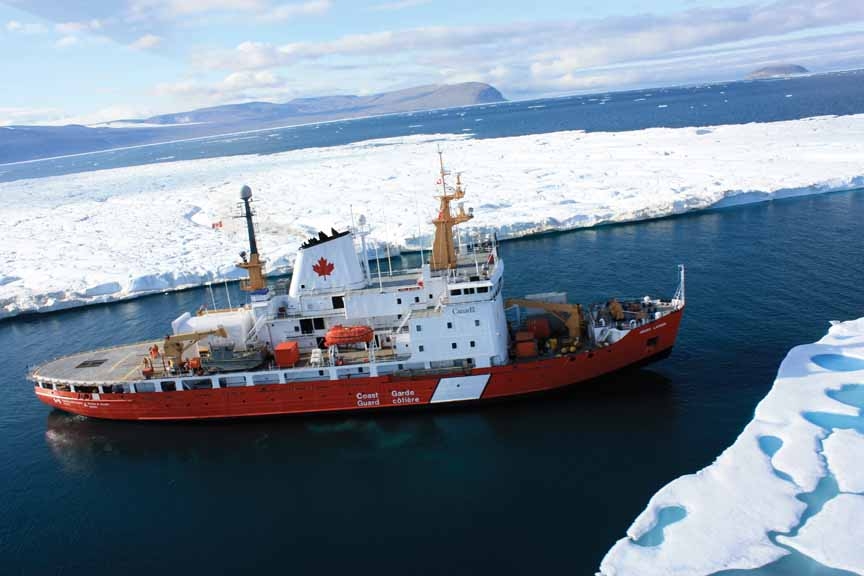
From Coast-to-Coast-to-Coast
Canada is a maritime country which generates a substantial amount of its GDP from exporting natural resources in today’s increasingly interconnected global economy. Its waterways serve as the maritime transportation network that contributes to the health, vitality and prosperity of the Canadian economy. Without safely navigable oceans and inland waterways, Canada’s position on the world stage would be compromised. And since Canada is home to one of the longest coastlines of any country in the world, the stakes could not be higher.
The responsibility of keeping Canada’s waterways navigable, as well as ensuring the safety and well-being of the crews and vessels that use those waterways, rests with the Canadian Coast Guard (CCG), which celebrated its 50th anniversary in 2012. The birth of the modern Canadian Coast Guard occurred on January 26, 1962, when Prime Minister John Diefenbaker established the CCG and outlined its three main responsibilities: “First, offering dedicated search-and-rescue services; second, maintaining Arctic sovereignty; third, responding to technical advances and increasing vessel traffic.” Today, 51 years later, that mandate remains unchanged.
The CCG’s roots extend back to the late 18th and early 19th centuries. The waterways in the Dominion of Canada were extremely treacherous. There were no safety standards to which ships had to be built and navigational aids were rudimentary at best, if not absent altogether. By the time the British North America Act of 1867 (now the Constitution Act, 1867) was ratified and the Dominion of Canada came into being, the waterways in the new Confederation were becoming more crowded than ever before. At the same time, the pace of shipbuilding worldwide was accelerating and many recently constructed commercial vessels were using relatively new (and substantially faster) steam-powered propulsion, as opposed to the long-standing naval reliance on the wind. With these developments, the number of passengers traveling by sea was increasing annually. The combination of these factors meant that the risks of — and consequences from — marine disasters were on the rise.
In 1867, amidst this unregulated and fast-paced new marine environment, the federal government inherited a number of what the modern-day CCG calls “elements of marine infrastructure – navigational aid systems; life-saving stations; canals and waterways; regulating organizations and enforcement vessels; and supporting shore infrastructure.” These elements of infrastructure were under the purview of the Department of Marine and Fisheries established in 1868. In 1930, the Department of Marine and Fisheries was broken up into two distinct ministries. In 1936, marine-based responsibilities and infrastructure came under the control of the Department of Transportation (DOT) — a move that brought with it the now familiar CCG duties of icebreaking and the maintenance of marine navigational aids.
The Canadian Coast Guard is the principal civilian maritime operational arm of the Government of Canada. Its activities and services are varied and complex, providing resources and support to the maritime element of Search and Rescue (SAR) operations and saving some 2,000 lives every year. It manages innumerable navigational aids to help vessels stay on course and is instrumental in the monitoring of naval traffic. It provides essential information to mariners and is involved in aquatic scientific research. It responds to naval-based environmental emergencies like oil spills. The CCG also provides ice-breaking services, ensuring that Canadian shipping channels are ice-free.”
These activities continue to be carried out on a daily basis in the three separate CCG regions of operation which were consolidated in October from the five created shortly after the inception of the CCG. The previous long-standing five regions of operation (the Pacific, Central & Arctic, Quebec, the Maritimes, and Newfoundland and Labrador) were streamlined into three larger zones of operation known as the Western region, the Central and Arctic region, and the Atlantic region.

Jody Thomas, Deputy Commissioner of Operations for the CCG, said this decision was made “as part of the Canadian Coast Guard’s strategic and operating review process.” Thomas explained that simultaneously reducing the number of operating zones while expanding their size would allow the CCG to function more efficiently and effectively, thereby “reducing costs to Canadians without reducing services to Canadians.”
When the CCG was founded in 1962, it commissioned over 40 vessels ranging from search-and-rescue cutters to large icebreakers. Since then, its fleet has expanded to 119 vessels and 22 operational helicopters. It also has a staff of some 4,500 employees, about half of whom work on land. Like their sea-based colleagues, the land-based CCG employees often perform essential services that are required to help the CCG carry out its mandate of promoting accessibility to, and safety on, our nation’s waterways. Some of the essential services include the maintenance of marine communications and navigation, electronic naval technological development and engineering services.
Whether operating on land or sea, the CCG comes under the umbrella of the Department of Fisheries and Oceans (DFO) where it provides material and human resources for the Search and Rescue Program (SAR) in matters involving federal jurisdiction and responsibility. This is perhaps the best-known function of the CCG.
Stay tuned to our series on the Canadian Coast Guard. The next issue will pick up where this brief historical overview leaves off, with a more detailed discussion and analysis of the essential services provided by the CCG, a behind-the-scenes look at the vessels, vehicles and technology that allow the CCG to deliver its services. There will be a few surprises, that will appeal to the seasoned naval historian and the casual reader alike.
Canadian Coast Guard Facts
To the Rescue
In early June 2010, the CCG contributed to the Gulf of Mexico oil spill relief efforts by sending 3,000 metres of off-shore boom to Louisiana. Several Coast Guard regions joined forces to make this offer of assistance possible, all while maintaining a reasonable response capacity in Canada.
Best Coast Guard College in the World
The Canadian Coast Guard College (CCGC) has a stellar reputation as one of the best Coast Guard colleges in the world. It has provided a free, world-class marine education to thousands of Canadians since its creation, in 1964. Located in Sydney, Nova Scotia, the CCGC is the place to go for aspiring ship’s officers. Upon completing their studies, graduates are guaranteed a job on a CCG vessel.
Keeping Canada Safe
The Marine Communications and Traffic Services (MCTS) of the CCG are a year round, 24/7 operation. Traffic Services personnel watch the waters and listen to radio transmissions to keep Canadian waters safe, secure and navigable.









